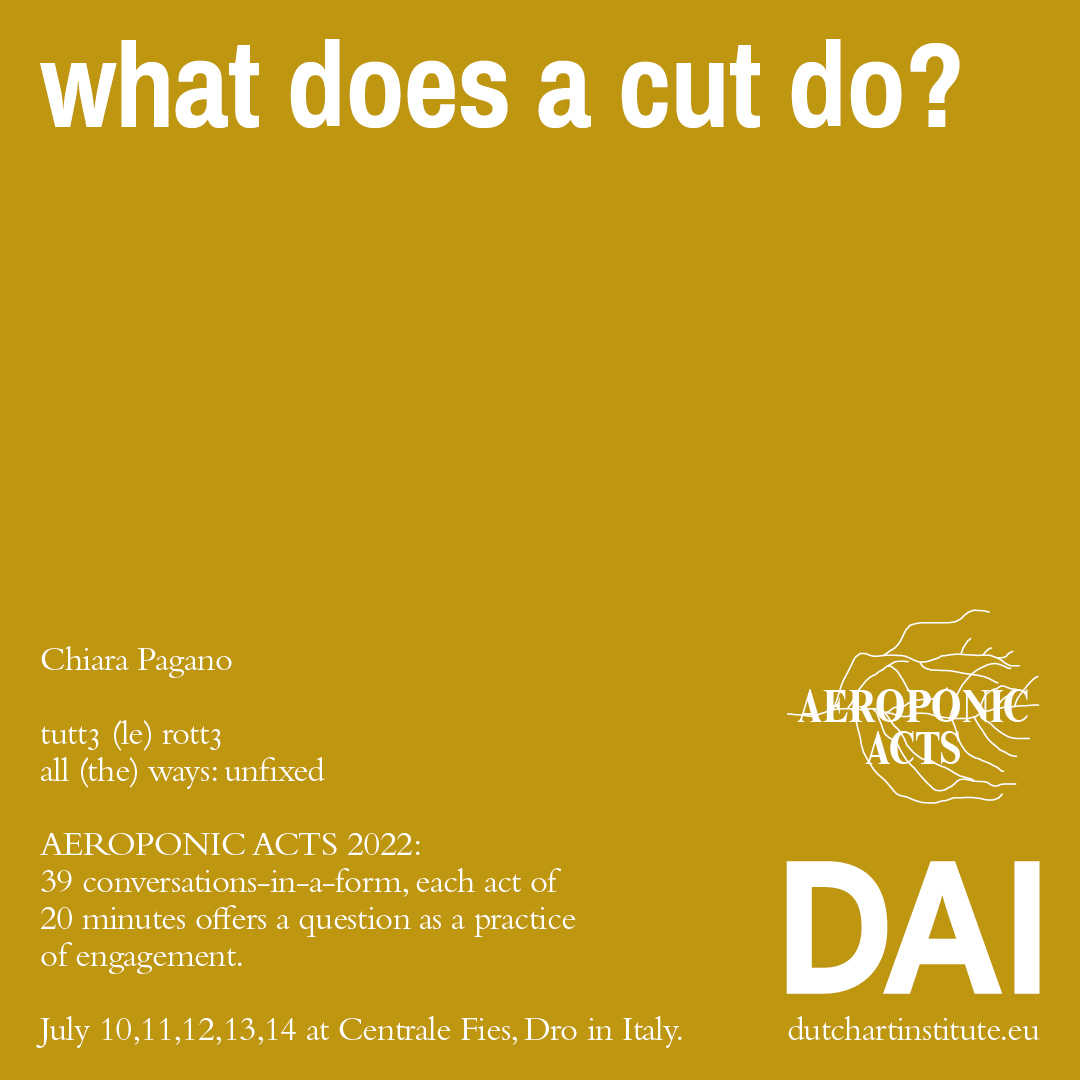Chiara Pagano: pulled tongues
‘Aeroponic’ – root systems nourished by air – Acts is the name given to the nomadic Dutch Art Institute’s final Kitchen presentations. Each participant addresses one question, as a practice of engagement.
Here you will find the documentation of Chiara Pagano's presentation as filmed by Baha Görkem Yalım. The written report is by Hubert Gromny and it includes a summary of the comments by esteemed guest respondents.
pulled tongues
Chiara's question: what does a cut do?
Chiara's introduction: it murmurs inside.
it murmurs.
inside is the fear of speech, the fear to say.
larger still. greater that is the pain not to say. to not say.
says nothing against the fear to speak.
it festers inside. the wound, liquid, dust.
Must break.
Must void.
Hubert's report: The audience enters a dark space set as a frontal stage. Uncanny music and smoke create a sense of a dramatic atmosphere. On the stage four performers (Chiara Pagano, Elisa Giuliani, Alexandra Martens Serrano, Lacey Verhalen) are sitting on the floor in the exact same position facing the audience. All of them have black clothes and wear similar make up. With the appearance of samples of “Ignee Spiritius” composed by Hildegard von Bingen within the sound piece performers begin to move and conduct a figurative choreography of slow and symbolic gestures. The light changes and the fifth performer, Pelumi Adejumo, enter the stage to read a text of an ominous and prophetic tone. Sound becomes more eerie and resembles voices of animals, while the atmosphere of the whole performance acquires a liturgical quality. Pelumi sings in a powerful voice and leaves the stage. Four remaining performers move slowly to the edge of the stage, where the bowl with some light substance is placed. They dip their hands in it and apply white material on each other's faces and draw black lines around each other's eyes. After that they form the group on the side of the stage. Soon the red spotlight isolates Elisa from the group, who enters the stage and begins a solitary dance whose moves resemble a tall, long-legged, long-necked bird struggling to fly. The movements become more and more intermittent and irregular. The sounds and light fade out slowly announcing the end of the performance.
Momtaza Mehri shared her interest in woundedness as a state of being, a condition and a tactic. The performance dwells in the wound and explores the void space of the hurt. Momtaza noted that performing a wound collectively is an interesting decision, as often dwelling in the wound can be self-indulgent. At the same time the wound is frequently culturalized and denied to exist in order to secure productivity of the system---collectivizing the wound has a potential of renewal and creativity. Reflecting on the sound, she pointed towards the animalistic component of the performance, which was present also as the bird-like, jerky dance at the end. The animalistic component does not conform to linearity and as such poses questions about how we locate ourselves and how we begin to heal the wound.
Ana Teixeira Pinto invoked a John Peale Bishop’s poem "Speaking of Poetry" by John Peale Bishop and recited the line “ceremony must be found.” Ana commented that the performance successfully found a ceremony, but the question that follows is what is the content of the ceremony, who or what is celebrated? Ana elaborated also on the notion of the cut and gestures used in the choreography as signifiers of a gender dimension within the piece. The synchronization of performers seemed to mimic mechanical, industrial production. At the same time choreography enacted gestures, which contain inscriptions of the ancient and of the sacred—evoking especially deities of Ishtar, Isis and their syncretization into Virgin Mary. Referring to the book by Stefanie Cob “Dying to be a Man” Ana spoke about becoming a saint as a modality of acquiring self-possession within the framework of Christian tradition. In this context the notion of the cut has another dimension---in hagiography of Christian saints the cutting of parts of the body is a method of de-gendering and re-gendering bodies and this dynamics was in various ways present within the presentation. Ana added that gestures used during the performance very much allude to the renaissance tradition of painting and other figurative languages embedded in the representation of white femininity. In this context Ana suggested to reflect on the entanglement between elegant aesthetics and torturous paths that femininity sometimes undertakes.
Chiara Figone pointed out the striking stillness of the bodies at the beginning of the performance. Almost sculptural choreography where each gesture was controlled and acted collectively marked a tension between bodies. In contrast the final dance was full of uncontrolled and unusual movement and seemed to be a moment of liberation and transforming the constraint into something else. It was marking both the potentiality of lightning and liberating the self, but also of falling into the void. While during the performance all the bodies were together, being synchronized at first and later gathering in the collective moment of attending each other, the bird-like dance was a moment of individuality and moving away from the collective. Chiara commented also that the presentation raised questions about how and if bodies can be muted and heard. The stillness of the body was rendered as a way of telling, which inverted the idea of what is muted, not said and not heard. Evoking the work of Gloria Anzaldua and the notion of wild tongue Chiara spoke about how disciplining the tongue was used to control the female body.
Chiara Pagano's "pulled tongues" was presented before live audience at the Centrale Fies, Dro, Italy on July 11th.
Find the overview of all 24 AEROPONIC ACTS 2022 here: tuttə (le) rottə - all (the) ways: unfixed


